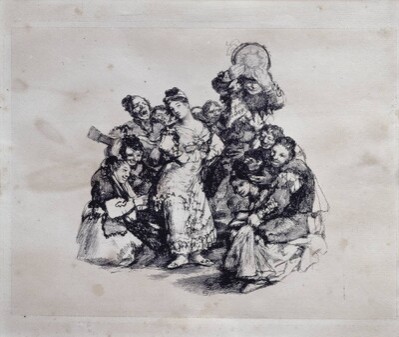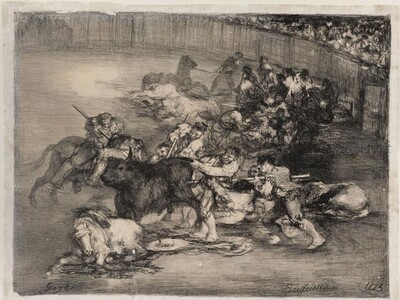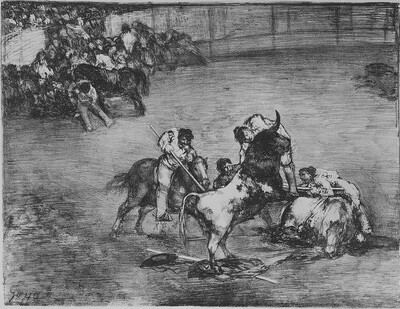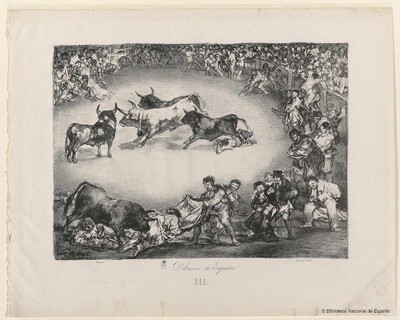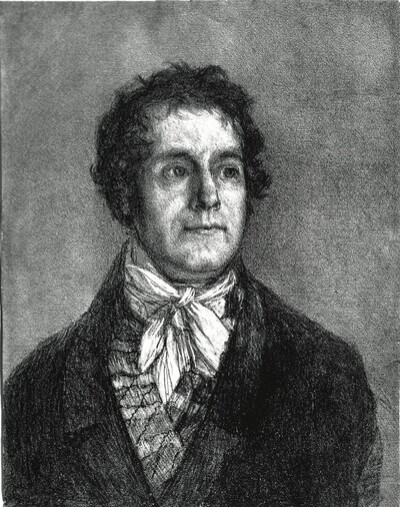- Cronología
- 1819
- Dimensiones
- 120 x 128 mm
- Técnica y soporte
- Piedra litográfica, pincel y pluma, tinta negra, papel de color
- Reconocimiento de la autoría de Goya
- Documented work
- Ficha: realización/revisión
- 09 Feb 2011 / 14 Apr 2023
- Inventario
- 225
Madrid February 1819 (under the stain).
Goya (lower central area).
The introduction of lithography in Spain was due to the initiative of José María Cardano, who on 16 March 1819 inaugurated the first lithographic workshop in Madrid called The Lithography of Madrid, also known as the Lithographic Establishment of Madrid, which depended on the Hydrographic Depot of the Secretariat of the Navy, This organisation had been created in 1770 and had been established in Madrid since 1789 at number 4 Hortaleza Street, in the so-called Casa de la Platina, for the purpose of storing the cartography produced as a result of the expeditions of the navigators, although it later dealt with the management and processing of charts, maps, plans, prints, etc. ... being active until 1825. Although Goya may have become acquainted with the lithographic technique through Bartolomé Sureda, he did not practise it until the beginning of 1819 in collaboration with Cardano, with whom he worked until the latter's departure abroad in July 1822. This work is his first lithographic essay, the first lithograph dated in Spain and also the first of at least ten prints that Goya produced in Spain before his trip to Bordeaux, including Duel in the Old Style, Infernal Scene, Monk, Expressive Double Force, The Rape, The Reading, Bull Beset by Dogs, Luck of the Stick in the Field and The Dream.
There are four known proofs of this lithograph: the Javier Salas collection, the National Library in Madrid, the British Museum in London and the Bloch collection.
The work, which is simple and easy to resolve due to its linear nature, shows an old woman seated on a stool against a neutral white background with no shadows. She extends her right arm from which she hangs the spindle to spread the thread. Her head is covered with a handkerchief and she wears a skirt and overskirt. Here Goya uses a human type that he would repeat in his later drawings, just as the theme of old age became recurrent in the last years of his life.
In the darker, overlapping areas there are some smudged areas.
The lithographs made in Madrid are not of high quality and must be considered essays, despite the excellent preparatory drawings, as neither Goya nor Cardano had yet mastered the technique, and inadequate paper was used. For this reason, some of these prints had to be retouched with pencil or ink, and the print runs are very short, even single proofs in some cases.
-
Grabados y dibujos de Goya en la Biblioteca NacionalBiblioteca NacionalMadrid1946catalogue Elena Páez Ríos
-
Goya: zeichnungen, radierungen, lithographienInternational TageIngelheim1966exhibition displayed from May 7th to June 5 th 1966
-
The Changing Image: Prints by GoyaMuseum of Fine ArtsBoston1974From October to December 1974. Exhibited also at The National Gallery of Canada, Ottawa, January to March 1975
-
Goya en la Biblioteca Nacional. Exposición de grabados y dibujos en el sesquicentenario de su muerteBiblioteca NacionalMadrid1978May - June 1978
-
Grabados de Goya: colección propiedad de la Biblioteca Nacional, que se conserva en su Gabinete deCasa de la Amistad de MoscúMoscow1979exhibition displayed from January 18th to 31st 1979
-
Goya (1746-1828). Peintures-Dessins-GravuresCentre Cultural du MaraisParís1979consultant editors Jacqueline et Maurice Guillard
-
Goya: Zeichnungen und DruckgraphikStädtische Galerie im Städelschen KunstintitutFrankfurt1981from February 13th to April 5th 1981
-
La litografía en Burdeos en la época de GoyaAyuntamiento de ZaragozaZaragoza1983organized by Ayuntamiento de Zaragoza. On January 1983. Celebrated also in Bordeaux, on May 1983.
-
Origen de la litografía en España. El real establecimiento litográficoMuseo Casa de la MonedaMadrid1991From 31 October to 15 December 1991.
-
Ydioma universal: Goya en la Biblioteca NacionalBiblioteca NacionalMadrid1996from September 19th to December 15th 1996
-
Goya grabadorMuseo del Grabado Español ContemporáneoMarbella1996from March 8th to May 5th 1996
-
Francisco Goya. Sein leben im spiegel der graphik. Fuendetodos 1746-1828 Bordeaux. 1746-1996Galerie KornfeldBern1996from November 21st 1996 to January 1997
-
Goya. Grabados y LitografíasBuenos AiresEmecé1961
-
Goya engravings and lithographs, vol. I y II.OxfordBruno Cassirer1964vol. I y II, 1964, p.418, cat. 270
-
Francisco Goya Lucientes. Los toros de BurdeosMadridEdiciones de Arte y Bibliofilia1965
-
Vie et ouvre de Francisco de GoyaParísOffice du livre1970p. 329, cat. 1643
-
Las Litografías de GoyaBarcelonaEditorial Gustavo Gili, S.A1982
-
Origen de la litografía en España. El real establecimiento litográficoMadridFabrica Nacional de Moneda y Timbre1990pp. 54-64 y 362, cat. 21
-
Ydioma universal: Goya en la Biblioteca NacionalMadridBiblioteca Nacional, Sociedad Estatal Goya 96 y Lunwerg1996pp. 277-289
-
Catálogo de las estampas de Goya en la Biblioteca NacionalMadridMinisterio de Educación y Cultura, Biblioteca Nacional1996p. 254, cat. 400
-
Goya. Estampas. Grabado y litografíaBarcelonaElecta ediciones2007pp. 329 y 373, núm. 265

